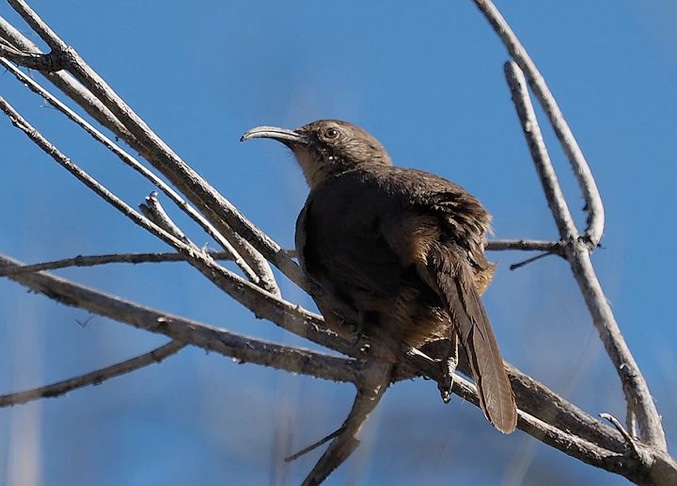A practical guide to bird watching in Sonoma County, California
(Unless otherwise indicated, all phone numbers are in the 707 area code)
A practical guide to bird watching in Sonoma County, California
(Unless otherwise indicated, all phone numbers are in the 707 area code)


Once seen, not easily forgotten, the long, decurved bill of California Thrasher is impressive. California Thrasher is present year-round in Sonoma county where suitable habitat exists. A moderately common bird but hard to see because of its secretive habits and limited distribution. Endemic to California and northern Baja California. Prefers hilly chaparral but also found in moist woodlands with heavy brush cover. Occasionally turns up in more populated areas if there is adequate dense vegetation. In Sonoma County, perhaps best seen in the upland eastern parts of the county. Pine Flat Rd., Sugarloaf Ridge State Park, and Mt. St. Helena are good spots to look for California Thrasher here. Often found in the company of Wrentit (Chamaea fasciata), Spotted Towhee (Pipilo maculatus), and Blue-grey Gnatcatcher (Polioptila caerulea). California Thrasher requires extensive contiguous expanses of shrubby vegetation, which makes it particularly vulnerable to the effects of clearing for development. Numbers appear to be declining in Sonoma county.
Uses its long bill to dig and rake for food. Mostly eats insects, especially in the spring, but will eat fruit, acorns, or other seeds at other times of the year. Said to be particularly fond of poison oak and Toyon berries (Lukas). Can sometimes be detected before it’s sighted by its noisy digging. Once in a while, particularly during breeding season, birders get treated to a good view of a lustily singing bird on an exposed perch (as in the photo above).
Resembles an oversized California Towhee (Melozone crissalis) with a long, curved bill. Large, but not pudgy and with a long tail. Mostly greyish brown, but slightly paler below and with a buffy wash on the belly and at the vent. Paler also at the throat. Dark eye. Dark eyeline. Somewhat paler above and below the eye as well, but in the field the facial features (and the lighter color on the belly and vent) are more subtle than most field guide illustrations suggest and can be hard to detect. The most obvious visual feature of California Thrasher is its distinctive bill.
Trivia: California Thrasher is related to the Mockingbird (in the family Mimidae) and, like the Mockingbird, will sometimes imitate other birds during vocalization. The Latin name redivivum means “resurrected.” According to Vuilleumier, the bird was known to Western science as early as the 16th century but then “lost” until rediscovered in 1845. Named by Gambel in that year (as Harpes rediviva).
Selected county sightings: Healdsburg (Jan 23, 2022, Colin Talcroft); Pine Flat Rd. (Jun 1, 2013, Colin Talcroft); Pine Flat Rd. (May 13, 2013, Ruth Rudesill); Pine Flat Rd. (Apr 23, 2013, Gene Hunn); Mt. St. Helena (Mar 1, 2013, Scott Carey); Mt. St. Helena (Feb 10, 2013, Brook O’Conner); Sugarloaf Ridge State Park (Jan 30, 2013, Gene Hunn); Pine Flat Rd. (Jul 1, 2012, Alan Wight); Sugarloaf Ridge State Park (May 12, 2012, Robert and Edie Jackson); Pine Flat Rd. (May, 9, 2012, Ruth Rudesill); Pine Flat Rd. (May 3, 2012, Dan Nelson); Ragle Ranch Park (Apr 3, 2012, Bill Doyle)
Further reading:
Bolander and Parmeter, Birds of Sonoma County California, rev. ed., 2000, p. 99
Brinkley, National Wildlife Federation Field Guide to Birds of North America, 2007, p. 402
Burridge, ed., Sonoma County Breeding Bird Atlas, 1995, p. 138
Dunn and Alderfer, eds., National Geographic Field Guide to the Birds of North America, 5th ed., 2006, p. 365
Dunn and Alderfer, eds., National Geographic Field Guide to the Birds of North America, 6th ed., 2011, p. 406
Dunne, Pete Dunne’s Essential Field Guide Companion, 2006, pp. 513
Ehrlich, Dobkin, and Wheye, The Birder's Handbook, paperback edition, 1988, p. 476
Fix and Bezener, Birds of Northern California, 2000, p. 306
Floyd, Smithsonian Field Guide to the Birds of North America, 2008, p. 367
Kaufman, Field Guide to Birds of North America, 2000, p. 262
Lukas, Bay Area Birds: From Sonoma County to Monterey Bay, 2012, pp. 231-233
Parmeter and Wight, Birds of Sonoma County California, Update (2000-2010), 2012, p. 59
Peterson, Field Guide to Birds of Western North America, 4th ed., 2010, p. 296
Peterson, Western Birds, 3rd ed., 1990, p. 272
Sibley, Field Guide to Birds of Western North America,1st ed., 2003, p. 354
Stokes, Stokes Field Guide to the Birds of North America, 1st ed., 2010, p. 576
Vuilleumier, American Museum of Natural History, Birds of North America: Western Region, 2011, p. 456
Voice: Cornell Lab of Ornithology: All About Birds--California Thrasher
© Colin Talcroft, 2009-2022
Unless noted, all photos by the author. If you would like to use one of my images, please ask for permission for non-commercial use with proper credit or commercial use with proper compensation.

California Thrasher
Toxostoma redivivum
California Thrasher, Pine Flat Rd., Healdsburg, June 1, 2013

1990-2013 Sonoma County data. Graph provided by eBird (www.ebird.org), generated May 30, 2013
Reported occurrence in Sonoma County


California Thrasher (Toxostoma redivivum), on the Russian River, near Healdsburg, California, January 23, 2022